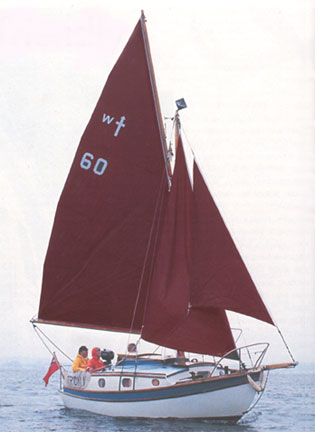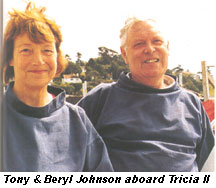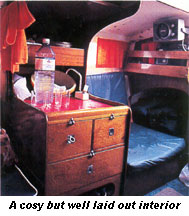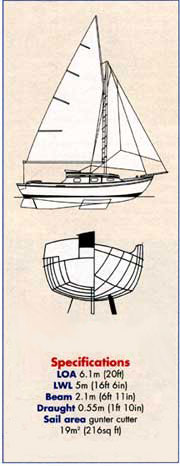ONE MAN AND HIS BOAT
| Tony Johnson retired from the Police in 1982 having been a leading light in the development of the
Northants Police
Sailing Section. Tony competed in the early
Police National Dinghy regattas at Hayling Island and Sunderland.
In his later years he transferred from dinghies to
yachts. This story was first published during the 1990's in 'Yachting
Monthly' to whom we are extremely grateful. |

|
"Cranium-friendly cruising"
-
Tony & Beryl Johnson's Westcoaster "Tricia II"
A rendezvous with Tony and Beryl Johnson aboard their
Westcoaster Tricia II in Poole Harbour calls for careful planning. Since Tony
retired from the rank of Inspector with the Northamptonshire Police in 1982,
time afloat has to be juggled with bowling and looking after the gardens of his
three grown-up children. Nonetheless, several weeks are inked in the diary for
the boat, come rain or shine. And even on a rainy day early in the season,
Tricia II was a jolly sight with her pleasing palette of tan sails, varnished
spars and hatches, and a sky blue sheer between the white of her topsides and
cabin trunking.
Tricia II's hull is sturdily built with a double layer of 'outside quality' 6mm
(quarter inch) plywood pinned and glued to pine frames. Two galvanised ballasted keels,
136kg (300 lb) each, and a mahogany skeg keep her upright under sail and when
dried out on the mud. This arrangement also makes her eminently trailable, an
essential feature for Tony and Beryl, who take the boat on a 300-mile round trip
between home and the mooring each year.
It could be argued that Dennis Rayner's design for the
charming little Westcoaster is one of the most significant in family cruising
yacht history.
Rayner described the hull as of 'reduced chine' design, achieved by curving the
panels and avoiding the usual slab-sided plywood boat look.
 Via Yachting Monthly
he challenged anyone in a production cruising 'round-bilged boat of comparable
size'
to sail a match with him with 'fifteen-guinea stakes for each boat entering,
winner takes the kitty'. He proposed that boats be brought to the match on
trailers and that the first race of the day should be 'from the road to their
being afloat, rigged and underway'. The strengths of the Westcoaster so clearly
claimed by her designer have been confirmed by several generations of contented
cruising folk.
Via Yachting Monthly
he challenged anyone in a production cruising 'round-bilged boat of comparable
size'
to sail a match with him with 'fifteen-guinea stakes for each boat entering,
winner takes the kitty'. He proposed that boats be brought to the match on
trailers and that the first race of the day should be 'from the road to their
being afloat, rigged and underway'. The strengths of the Westcoaster so clearly
claimed by her designer have been confirmed by several generations of contented
cruising folk.
Right: Tricia II sailing in Poole Harbour.
"We bought Tricia II 17 years ago", Tony Johnson remembers. He graduated from
another gunter-rigged boat, the Mirror dinghy which he built himself and sailed
in police national regattas. 'The Westcoaster came from a deputy bank manager
who was moving up to a larger boat. "Gunter is a rig I like because it has a
certain traditional style about it", says Tony. Rayner was
quite adamant that gunter was the best rig for small shoal-draught cruising
boats. Unlike bermudian, it does not leave a naked spar aloft when
the mainsail is reefed, and since the yard allows the top of the sail to twist,
more of the wind's energy goes into driving the boat forwards. Also, as the
mainsail falls readily towards the deck when halyards are started, the simple
galvanised steel drum and wire pennant reefing gear - exactly as fitted to
Tricia II - is ideal, with all lines controlled from the cockpit.
"The Westcoaster is very good in a blow. The cutter sailplan
lets us furl the staysail before reefing the mainsail", says Tony. The staysail is the No.1 jib
of the bermudian Westcoaster, the No.2 being the jib. One-time roving YM
contributor Martin Guppy proved the Westcoaster's sea-keeping qualities beyond
doubt when he circumnavigated Britain in Karen Elizabeth. Hove-to, the boat rode
out heavy weather as happily as a puffin. 'She's a lovely boat on a reach, so
stable and comfortable, and very dry,' says Tony. 'The twin keels and skeg keep
her on course when running.'
There is no danger of being 'overboated' with a Westcoaster, but she's cosy
without being cramped thanks to sensible design.
 A cabin table is stored flat
beneath the foredeck until it is slotted into position between two 'sideboards'
flanking the cabin. One is glass-fronted, reminiscent of a 1950s living room
display cabinet, although it contains half a dozen eggs and the amber nectar of
the Scots rather than figurines. The full-width coachroof certainly makes for a
cranium-friendly cabin, and the two settees can be combined to make a large
double berth. Years ago, when the Johnsons' sons were on board, the two
quarterberths were used as well, a full 2m (6ft Sin) long.
A cabin table is stored flat
beneath the foredeck until it is slotted into position between two 'sideboards'
flanking the cabin. One is glass-fronted, reminiscent of a 1950s living room
display cabinet, although it contains half a dozen eggs and the amber nectar of
the Scots rather than figurines. The full-width coachroof certainly makes for a
cranium-friendly cabin, and the two settees can be combined to make a large
double berth. Years ago, when the Johnsons' sons were on board, the two
quarterberths were used as well, a full 2m (6ft Sin) long.
Tony and Beryl have lost count of the number of miles beneath
Tricia II's keels,
but some passages stick in the memory. 'The first time we attempted the crossing
to Cherbourg, we encountered a thick blanket of fog and decided to turn back. As
we passed under Anvil Point lighthouse, we could hear the foghorn sounding but
we couldn't see anything. When we came into Studland Bay under outboard, there
was a long string of boats behind us, including a sail training ship.'
Is Tricia II in the GPS age? 'Good Lord, no! We almost belong to the paraffin
lamp era,' Tony chuckles. Seamanship aboard Tricia II is in the crew rather than
electronic ornaments.  Over three years, Tony did a Yachtmaster course when they
first started cruising. Now a trailing log, depth sounder and hand-held RDF are
in regular use, and there is a smart new grouping of barometer, chronometer and
clinometer mounted on the forward cabin bulkhead.
Over three years, Tony did a Yachtmaster course when they
first started cruising. Now a trailing log, depth sounder and hand-held RDF are
in regular use, and there is a smart new grouping of barometer, chronometer and
clinometer mounted on the forward cabin bulkhead.
'For cooking on board we have two burners and a grill,' says Beryl. 'We bring
fresh things down to start the week and wherever we have a run ashore we go to
the butcher and buy some nice fresh steak. Yes, we're still eating it!' A
favourite run is to Newtown Creek on the Isle of Wight. They drop anchor just
inside the creek and push upstream with the tender. A stroll through fields
takes them to a fresh lobster salad and home-made pie at the local pub.
'Absolutely wonderful,' says Tony.
They rate local knowledge highly and reckon that Poole
Harbour is ideal for a week afloat. 'Whichever way the wind is blowing there is
shelter when you need it.  We've
taken note of what the locals have told us.' With a draught of about 0.6m (2ft)
there are not many places on the South Coast which are not accessible, but
capability has not been allowed to diminish caution.
We've
taken note of what the locals have told us.' With a draught of about 0.6m (2ft)
there are not many places on the South Coast which are not accessible, but
capability has not been allowed to diminish caution.
'Some years ago it was blowing hard when we dropped anchor,' says Tony. 'People
had told me that the harbour bottom can be a problem so I let the others go to
bed while I sat up all night in the cockpit. In the morning the anchor was solid
in the mud. I'd sat up for nothing! If the Danforth does stick we tighten the
warp around the
Sampson post and sit at the stern. The leverage gradually breaks it out.'
One aspect of life afloat which the Johnsons enjoy thoroughly is the complete
surprise of meeting some of the great characters of the sea. For example, Tony
recalls when they hired a boat on the East Coast. 'I saw a barge, and I saw the
quay, but what I didn't see was the wire hawser which was under the water and
being winched to bring the barge alongside. We finished up with the hawser round
our prop and the barge's winch drum on our boat. It turned out to be Bob Roberts
and the old Thames sailing barge Cambria, the last to trade under sail. He was
as nice as pie.'
Tony and Beryl have thought about 'going bigger' but they've seen too many
people do exactly that and regret it. 'The Westcoaster is still the right boat
for us,' Tony concludes. 'Yachting has been wonderful. We've had a great time.'
Original article from Yachting Monthly, by Robin Gates
© 'Yachting
Monthly'

 Via Yachting Monthly
he challenged anyone in a production cruising 'round-bilged boat of comparable
size'
to sail a match with him with 'fifteen-guinea stakes for each boat entering,
winner takes the kitty'. He proposed that boats be brought to the match on
trailers and that the first race of the day should be 'from the road to their
being afloat, rigged and underway'. The strengths of the Westcoaster so clearly
claimed by her designer have been confirmed by several generations of contented
cruising folk.
Via Yachting Monthly
he challenged anyone in a production cruising 'round-bilged boat of comparable
size'
to sail a match with him with 'fifteen-guinea stakes for each boat entering,
winner takes the kitty'. He proposed that boats be brought to the match on
trailers and that the first race of the day should be 'from the road to their
being afloat, rigged and underway'. The strengths of the Westcoaster so clearly
claimed by her designer have been confirmed by several generations of contented
cruising folk. A cabin table is stored flat
beneath the foredeck until it is slotted into position between two 'sideboards'
flanking the cabin. One is glass-fronted, reminiscent of a 1950s living room
display cabinet, although it contains half a dozen eggs and the amber nectar of
the Scots rather than figurines. The full-width coachroof certainly makes for a
cranium-friendly cabin, and the two settees can be combined to make a large
double berth. Years ago, when the Johnsons' sons were on board, the two
quarterberths were used as well, a full 2m (6ft Sin) long.
A cabin table is stored flat
beneath the foredeck until it is slotted into position between two 'sideboards'
flanking the cabin. One is glass-fronted, reminiscent of a 1950s living room
display cabinet, although it contains half a dozen eggs and the amber nectar of
the Scots rather than figurines. The full-width coachroof certainly makes for a
cranium-friendly cabin, and the two settees can be combined to make a large
double berth. Years ago, when the Johnsons' sons were on board, the two
quarterberths were used as well, a full 2m (6ft Sin) long. Over three years, Tony did a Yachtmaster course when they
first started cruising. Now a trailing log, depth sounder and hand-held RDF are
in regular use, and there is a smart new grouping of barometer, chronometer and
clinometer mounted on the forward cabin bulkhead.
Over three years, Tony did a Yachtmaster course when they
first started cruising. Now a trailing log, depth sounder and hand-held RDF are
in regular use, and there is a smart new grouping of barometer, chronometer and
clinometer mounted on the forward cabin bulkhead. We've
taken note of what the locals have told us.' With a draught of about 0.6m (2ft)
there are not many places on the South Coast which are not accessible, but
capability has not been allowed to diminish caution.
We've
taken note of what the locals have told us.' With a draught of about 0.6m (2ft)
there are not many places on the South Coast which are not accessible, but
capability has not been allowed to diminish caution.